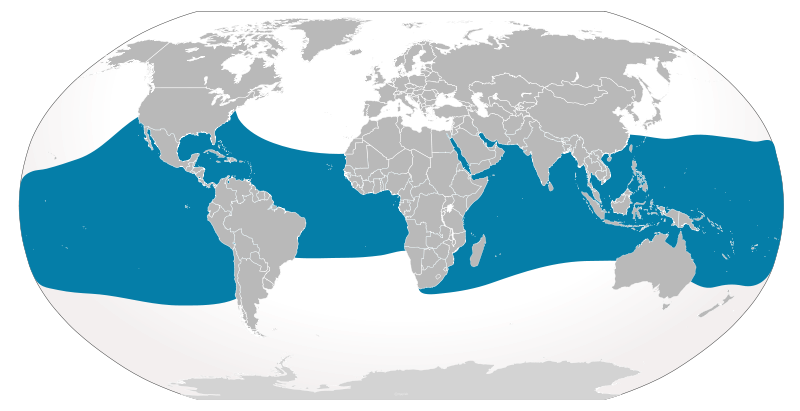Habitat
The map below shows where whale sharks can generally be found!
The whale shark (Rhincodon typus) is a species that
is distributed throughout
warm and tropical seas. In 1986, R.typus was said to be
very unpredictable and there
was not a credible source of data about R.typus sightings
(Stevens, 2007). From that
time to the present, our knowledge about their biology and ecology
is still unclear..
Though unclear, some locations can be predicted now because of
further research on
this species. R.typus has a pelagic habitat, meaning a
habitat within the water
column. From studies, R.typus prefer water temperatures
from 21°-25° with a
certain percentages of salinity, where zooplankton can become
abundant, which is a
major food source for R.typus (Stevens, 2007).
 They like a generally warm habitat,
They like a generally warm habitat,
and therefore tend to migrate very
often, due to environmental changes.
This is why R.typus are very
unpredictable and are only known to
stay in a certain area for a short
period of time. One common area
where R.typus is found is the Meso-
American Barrier Reef System
(MBRS) which stretches from the
Yucatan Peninsula all the way to Honduras. This area is very popular
for marine
tourists because of R.typus activity. The MBRS is very
diverse with different currents
and a diverse population of prey. R.typus is known to move
closer inshore to feed on
zooplankton, offshore to feed on tuna eggs, and larger R.typus
have been observed
in the northern Gulf of Mexico as well as the MBRS. There seems to
be size
segregation in the R.typus community. There were no whales
of less than 2m
recorded in the northern Gulf of Mexico. There seems to be a
population of larger
R.typus in the Atlantic Ocean, and is speculated that the
larger R.typus move into
the Atlantic Ocean to breed.
Continue Learning? Go on to the
Form/Function
page!
Or go back to the Home page!

